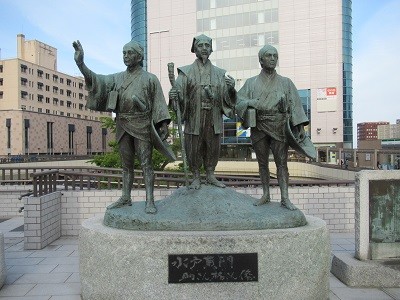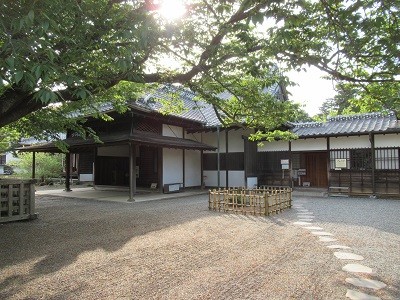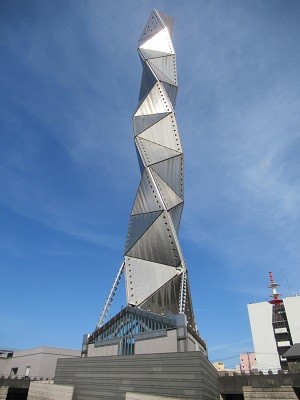Mito is located in Ibaraki Prefecture, northeast of Tokyo, and in the middle of the prefecture. Although it is Ibaraki’s capital city, it is not very large with a population of about 270,000. Mito has a history that dates back to the beginning of the Edo period, and there are some good attractions. The plum blossoms in Mito are a must-visit if you are in the area in the early spring.
History of Mito Domain
The beginning of the city development started in the early 17th century. At that time, Tokugawa Yorifusa came here as a feudal lord of the Mito domain. He was one of the sons of the Tokugawa Shogun. It was the Tokugawa family who started the shogunate government in Edo (Tokyo) in 1603. The Mito domain was one of the Gosanke, the three noble branches of the Tokugawa clan. If there was no direct descendent in the first shogunal family, the next Shogun would be adopted from these branches to maintain the line from the first Shogun Ieyasu. Actually, the last Shogun Yoshinobu was nominated from the Mito domain.
Second lord Mitsukuni (1628-1700), the third son of the first lord, was important in Japanese history. He promoted Confucianism and established Mito-gaku, a historical and Shinto school in Mito. Based on this study he started writing an important history book. The ‘Dainihonshi’ or ‘Great History of Japan’ was completed in the Meiji period (1868-1912). He also renovated Koishikawa Korakuen Garden which was built by his father.

End of Samurai Rule
The 9th lord Nariaki was also powerful. He completed a big reform of the domain and he became the shogunate’s minister of defense. It was the time when Commodore Mathew Perry came to Japan to order to open the country after centuries of seclusion. He insisted on the idea of “Respect the Emperor and Expel the Barbarians”. But he was placed in confinement at home by Prime Minister Ii.
His son Yoshinobu went on to become the 15th Shogun. But he could not control the rising power of the feudal lords. So he gave back the power to the Emperor in 1867. This marked the end of the shogunate and the beginning of the modernization of Japan.
Mito Castle
The history of the castle in Mito dates back to the 12th century when Baba was the lord. After him, Satake was the lord until Tokugawa Yorifusa came here in 1603. The successive Mito-Tokugawa lords normally stayed in Edo, so Mito Castle was simple. Unfortunately, the castle tower was destroyed during WWII, and there are only a few constructions remaining from the feudal time.
Kodokan
Kodokan was the school of the Mito domain which was built in 1841 by the 9th lord Nariaki. It was the largest school made by a domain in Japan and is the only remaining building in Mito from the feudal time.

The school was built to make it possible to adopt human resources widely from the lower-ranked people. In fact, this was one of his most important policies of administrative reform. The admission age was 15, but there was no official graduation. Both traditional academics and military arts were emphasized at the school. Students learned Confucianism, courtesy, history, astronomy, mathematics, map, poem, music, and so on. Military subjects were fencing, spear-wielding, martial art, military strategy, the operation of guns, horse riding, swimming, and so on. They closed in 1872 when the new government established a modern school system.
Access: 8 minutes walk from JR Mito Station. It takes 70-80 minutes from Tokyo to Mito by express train.
Fee: 400 yen for adults / 200 yen for elementary and middle school students
Hours: 9 am to 5 pm (from April to September) / 9 am to 4 pm (from October to March)
Kairakuen Garden
Kairakuen Garden was also built by lord Nariaki in 1842. The name comes from a saying in the Confucian book ‘Mencius‘. It states that “the ancients would share the pleasures with people, so their pleasure would be hearty and deep”. It means that not only samurai clan members but also common people could enjoy it.


The garden is regarded as one of the three great gardens of Japan. Its plum garden is very popular with more than 3,000 plum blossom trees of 100 varieties. Also, you can see other seasonal flowers such as rape blossoms, azalea, and the cosmos. And to top it off, the view of Lake Senba from the garden is spectacular.
Access: 20 minutes by bus from JR Mito Station.
Fee: 300 yen for adults / 150 yen for elementary and middle school students
Hours: 6 am to 7 pm (from April to September) / 7 am to 6 pm (from October to March)
Ibaraki Prefectural History Museum
In this museum, you can learn about the history of Mito from ancient times to now. The Hitotsubashi-Tokugawa Family Memorial Hall exhibits the cultural properties and historical documents of the Tokugawa family. In the garden, you can find an old elementary school which was built in 1881. Moreover, it is an important cultural asset because it shows the early architectural style of Japanese elementary schools.
Access: 20 minutes by bus from JR Mito Station.
Fee: 160 yen for adults / 80 yen for university students / free under high school students
*The admission fee varies per special exhibition
Hours: 9 am to 5 pm
Mito Geijutu-kan (Art Tower Mito)
Mito Geijutu-kan or Art Tower Mito is a complex of an art museum, concert hall, and theater. It was constructed in 1990 and designed by Isozaki Arata. The spiral-shaped tower is the symbol of the complex and also of the city. Standing at 100 meters, it is fun to go up to the observation deck at 86 meters by elevator.

The museum doesn’t have one permanent collection. In fact, they always hold a temporary exhibition of modern art. Their objective is trying to talent-spot young artists. So what you will see here is always a surprise!
Access: 20 minutes walk from JR Mito Station.
Entrance Fee Tower: 200 yen for adults / 100 yen for junior high and elementary school students
Entrance Fee Art Museum: 900 yen for adults / Free under senior high school students
Hours: 9 am to 6 pm / Closed on Monday
Your Japan Tour
As seasoned Japan experts, we can help you create your perfect Japan tour. We can provide you with guides who can tell you all about the sightseeing spots in Mito. The guide can take you to the city and take you to the actual sites. Contact us to start planning your unforgettable holiday to this fascinating country. Japan is full of once-in-a-lifetime experiences, culture, history, nature, and delicious food!